
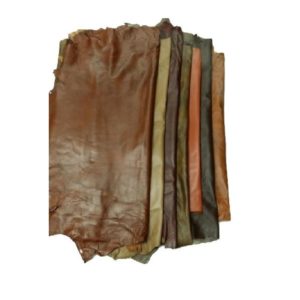
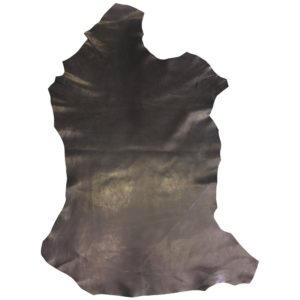
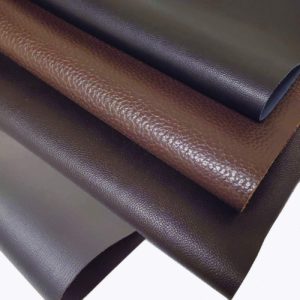
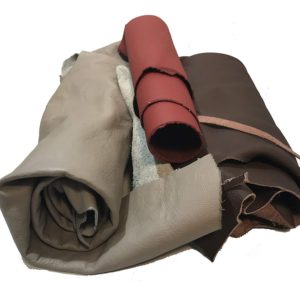
For most car owners genuine/natural leather is the chosen seat material for upholstery because of its comfortable feel and look. Make sure to invest in top-notch leather for car seats to get a number of benefits:
- Convenient since leather is a very supportive material. You may pair it with the right foam cushioning;
- Sturdy;
- Affordable maintenance – you just need to use special leather care products;
- Premium feel is one of the main reasons to buy genuine leather for your car upholstery;
Below you may find a few samples of the best leather for car seats. Consider buying a few sheets of these leather materials if you look for affordable and stylish car upholstery.
Reed Leathers Cow Skins–the best for versatility!
 Reed has produced a cowhide leather piece with a good texture and a chrome finish. It’s not especially dense, but it’s thick enough to be effective in a number of cases. It isn’t a full-fledged Napa leather, but it isn’t too grainy either.
Reed has produced a cowhide leather piece with a good texture and a chrome finish. It’s not especially dense, but it’s thick enough to be effective in a number of cases. It isn’t a full-fledged Napa leather, but it isn’t too grainy either.
The grain is noticeable but not overpowering. It is clean of faults such as scratches and gaps. Since the suede and grain parts of the leather are all medium pieces, you may choose any side.
Recommended for:
- Arts and crafts;
- Tooling;
- Stamping;
- Carving;
- Leather repairs;
- For book covers, car upholstery and lacing;
Pros
- Chrome finish;
- Medium thickness;
- Versatile uses;
- Nice quality;
- Each leather piece is unique;
- Flexible;
- Soft;
Cons
- Limited colors are available;
- May release chlorine gas due to the finish;
- Unpleasant odor at first;
The Reed’s leather piece is lovely, and it’s big enough to fit a large car seat. It has a medium thickness that is ideal for most sewing machines and manual leatherwork.
REED Leather Whole Sheep Skin– the best for the finish!
 Do you need durable and soft-to-the-touch leather materials for your DIY projects? Consider buying this Reed Leather Whole Sheep Skin product. It is actually a whole sheep hide. For this price, you may get one large or two small hides of soft sheepskin (from 7 to 10 sq. ft.).
Do you need durable and soft-to-the-touch leather materials for your DIY projects? Consider buying this Reed Leather Whole Sheep Skin product. It is actually a whole sheep hide. For this price, you may get one large or two small hides of soft sheepskin (from 7 to 10 sq. ft.).
Bigger hides can have age markings and cracks, while shorter skins are softer and have fewer marks.
The rustic pull finish on these sheepskin pieces is a good touch. The pull finish implies that when the hide is manipulated, it can take on a more rustic feel as it lightens in color.
Recommended for: car upholstery, crafts, soft garments and accessories. Good for making moccasins.
Pros
- Soft;
- Sturdy;
- A whole piece, no scraps;
- Different colors;
- Great antique “pull” finish;
Cons
- The edges are thinner;
- A bit greasy;
- The dye may leave stains on greasy palms – do not use for mittens;
The front of each part has a glossy natural surface, while the back has a rough surface.
This genuine leather lambskin hide will make a lovely addition to any DIY art project.
Leather Treasure Shop Lambskin Hide– the best for softness!
 Get the genuine thin lambskin piece by Leather Treasure Shop for its softness and flexibility. The rustic finish looks unique. Also, it is extremely durable and lightweight at the same time. Most users claim that it is very soft and flexible. The suede side is also very supple.
Get the genuine thin lambskin piece by Leather Treasure Shop for its softness and flexibility. The rustic finish looks unique. Also, it is extremely durable and lightweight at the same time. Most users claim that it is very soft and flexible. The suede side is also very supple.
Recommended for: home decor, small accessories, bookbinding, scrapbooking and car upholstery.
Pros
- Buttery soft;
- Great rustic finish;
- Flexible;
- Thin;
- Lightweight;
- Medium size;
- Easy to sew;
- Sturdy;
Cons
- Too small and thin for large DIY projects;
- Irregular shape;
- A bit dry;
This lambskin item is light and airy. It’s easy to deal with. It depends on your requirements, but experts suggest it if you need incredibly soft leather.
INCIRCLE Tooling Leather Square – the best for thickness!!
 This Incircle real cowskin piece offers a genuine leather material. Its most interesting feature is thickness. The leather material is slightly thicker than your standard upholstery leather.
This Incircle real cowskin piece offers a genuine leather material. Its most interesting feature is thickness. The leather material is slightly thicker than your standard upholstery leather.
A very nice piece of black color, with the slightly pebble-grained, chrome-tanned finish. The size of each piece is relatively small – only 2.2 sq. ft.
It is carefully cut, packaged and shipped from the South Korean factory.
Recommended for: arts and crafts, car upholstery, accessories and garments.
Pros
- 100% genuine cowhide leather;
- A bit stretchy;
- Easy to craft;
- Thicker than most leather upholstery materials;
- Not holes or strange marks;
Cons
- A too polished finish;
- Very chemical smell;
- Small size;
This is a stunning, large, and soft piece of leather. This leather comes highly recommended by most DIYers for every craft project.
Memory Cross Store Leather Scraps – the best for the price!
 This Memory Cross Store item is preferred for DIYers searching for affordable leather scraps for upholstery repair. Each pack comprises 2 to 7 parts, with a weight of about 2 pounds.
This Memory Cross Store item is preferred for DIYers searching for affordable leather scraps for upholstery repair. Each pack comprises 2 to 7 parts, with a weight of about 2 pounds.
Earth colors, such as black, blue, tan, green, and beige are prevailing. Metallic or other varying colors can be found as well, but each package with scraps offers different colors.
Whole hides, 1/2 hides, bigger parts, the hair on fur, and embossed leather scraps are possible in these packages.
Recommended for: this leather material is advised specifically for car upholstery and furniture projects. It’s also useful for producing watches, wallets, shoes, clothes, and trim pieces, according to several experts.
Pros
- Very affordable;
- From 2 to 7 pieces in one set;
- Nice shiny finish;
- Thick;
- Easy to sew;
Cons
- These are scraps, not whole pieces;
- More suede than smooth;
- Odd shapes;
- Color shades are weird;
- Looks like pleather;
These leather scraps are soft and between 1/16 to 1/8 inch wide, since they were made specifically for the furniture and automobile industries.
The Buyer’s Guide
At first, you should choose among different leather materials for your car seats:
- Aniline leather. Aniline leather is no longer commonly used for car seats. Aniline leather, on the other hand, is deemed the finest leather available since it is crafted from the best hides. It has a lot of colors and is very gentle to the touch. Just dyes have been used to stain this leather. It doesn’t have some sort of protective paint or surface pigment on it. You’re more apt to note the hide’s natural texture. Aniline leather, which lacks a waterproof layer, is the least prone to wear and needs extra treatment. It often loses its color easily.
- Semi-aniline leather. Aniline dyes are used to stain this leather. However, during the coloring treatment, the aniline leather is given a protective coat to make it more durable. The coat also tends to maintain the hue consistency. Semi-aniline leather is referred to as “done,” while aniline leather is referred to as “unfinished.” Semi-aniline leather maintains some of the fluffiness of genuine leather while still being much more prone to spills, bruises, and other wear. This form of leather is usually used in higher-end vehicles.
- Full-grain leather. Napa leather is made exclusively of full-grain leather. This material is typically used in high-end cars. The texture hasn’t been changed, but the original marks on the hide are still noticeable. Full-grain leather is sturdier than aniline leather since it has a heavier protective layer and pigmentation. It’s a downgrade from aniline leather, but it also has a comfortable feel to it.
- Corrected grain leather. It’s the least normal of all materials, but it’s still the most robust. While it always feels good to the touch, there is a definite contrast between this and aniline leather. The defects in the manufacturing products are more likely to be repaired during the smoothing process. If you have children or dogs, this is the kind of leather to use. This form of leather is used in automobiles with a lower to medium price range.
Here is how you can identify the leather type in a car:
- Add a water drop on the leather seat;
- Aniline leather will quickly absorb the water;
- Semi-aniline leather will need some time to absorb even a tiny drop;
- Corrected-grain and full-grain leather will repel the water. The drop will just slide;
Cloth vs leather for car seats
When it comes to car upholstery, Leather has long been deemed the supreme class mark, but there are plenty of die-hard followers of fabric seats as well. What is better for your car? Consider these things when comparing two different materials:
1) Appearance
Leather seats are frequently the preference of many buyers who enjoy design and patterns. The elegant, polished surface of high-quality leather has long been synonymous with luxury. Cloth seats, on the other side, do not have to be totally devoid of form. In reaction to market demand, producers have long sold increasingly chic fabric colors, styles, and textures.
2) Feel to the touch
Car seats are the primary point of communication for drivers and riders and the Car, so they must be secure. Inexpensive leather (or leatherette) can feel stiff and brittle, while high-quality leather can feel luxuriously smooth and supple.
3) Temperature
Since leather and fabric respond to heat differently, you should care about your environment while selecting between the two. Owing to the heat accumulation in a closed car, leather seats are infamous for being scorching hot while parked in intense sunlight for hours. This may be a major concern.
Leather seats lose heat easily in cold weather because even though the sun is streaming through the glass, you can be seated on a cold seat on a cold winter day. Manufacturers are well aware of the problem, and many cars now come fitted with heated seats (in cloth or leather) to help relieve the icy leather during cold weather.
Cloth, on the other side, retains a constant temperature independent of the season. On hot days, it may warm up a bit, while on cold days, it may be a little colder.
4) Maintenance routine
If you require a low-maintenance car, it will seem self-evident that cloth is the best alternative. Daily cleaning and conditioning with specific products are needed for real leather upholstery. If you miss this move, your leather can start to fade, crack, and look worn out faster than you’d like.
When cloth seats get dusty, though, they normally just need a simple vacuum and shampoo, which saves you a lot of time. The biggest downside to fabric seats is that deep washing them is more challenging.
5) Family health
Dust, pollen, and pet dander accumulate in a fragile atmosphere produced by fabric seats. Even a comprehensive vacuuming might not be enough to get rid of it all, particularly if you want to travel with your windows down or take your pet for car trips on a regular basis.
The shiny, non-porous surface of Leather, on the other side, allows it impossible for natural allergens to accumulate and adhere. Any of them can be extracted with a simple vacuum accompanied by a comprehensive wipe-down.
6) For pet owners
Pet owners have also confirmed that their four-legged friends have difficulties remaining in place on smooth leather seats during car trips. Cloth seats, on the other side, are normally soft, plush, and welcoming.
7) Price
Leather seats are sometimes more costly and are often packaged into expensive choice sets, while fabric/cloth seats are common in most versions. This is attributed to the basic cost disparity in fabrics – authentic leather must be tanned and matured in a time-consuming process, while cotton may be used right away. Keep in mind that natural leather seating can add a few hundred dollars to the original price of a car.
Tips for maintaining leather car seats:
- Clean the seats at least once every month;
- Keep the seats protected from direct sunlight. So keep the car in a shade;
- Dry clean the interior before conditioning;
- Condition/moisturize the natural leather upholstery for car seats at least every month. In such a way, you may avoid cracks in the leather material;
- Don’t be scared of putting too much leather conditioner. But wipe off the excess product with a dry microfiber cloth;
- After applying leave the conditioner for 30 minutes;
- Use the special leather products for maintenance;
Leather seats in a car must be both stylish and practical. The right choice of leather for car seats is extremely important and challenging. A large selection of smooth and perforated auto leather is available right now. Genuine leather is the most commonly used material in a car’s interior.
Car leather should have the best performance properties, as high durability, wear resistance, sound insulation, resistance to temperature fluctuations, changes in humidity, etc. Genuine leather seats in a car do not produce an annoying squeak of plastic and extraneous noises that will improve noise isolation. Top-notch leather for a car doesn’t accumulate sweat and moisture, it is pleasant to touch, it won’t burn out. Such a leather type possesses “breathing” properties, it is wear-proof, i.e. it practically does not deform.
How to choose leather for car seats?
When choosing leather for car seats, take into account its structure, which should match the structure of plastic parts imitating the leather surface. All automobile manufacturers set their technical requirements for genuine leather seats: stretching, abrasion, elasticity, permissible degree of humidity, etc., which should correspond to the car leather used in different brands like BMW, Audi, Mercedes-Benz, Ford, Jaguar, Opel, Porsche, Honda, etc. Among other things, the surface color and pattern must match the color and pattern of the plastic interior elements.
The right choice of color tone, texture, and quality of car leather is a combination of perforated leather with other fabrics in a car interior. When choosing the color of car leather seats, you should be guided by your personal preferences and the color of your car. When choosing genuine car leather for interior upholstery, the color tone, brightness, and saturation must be taken into account.
Personal top 5 leather types for car seats
I’ve been testing different leather types and brands for my BMW car seats for a few years. The results of my tests revealed top 5 brands that I definitely can recommend:
- REED is genuine cowhide leather (1.4 mm thick);
- REED also has a whole sheep leather skin that I use right now for my car’s seats. It also has a nice antique finish;
- Black Leather Hide sells a very smooth and soft lambskin type that is very thin (up to 0.8 mm);
- Incircle is another cowhide type that is quite thick and durable;
- Memory Cross sells durable leather types (2 inches to 24 inches);
Do you agree with my top 5 leather for car seats? Share your experience and preferences. Also, check the useful video about choosing the seat cushions and upholstery.
Useful Video: A Basic Seat Cushion Cover Car Upholstery
Final thoughts
For those who take pride in their car, leather car seats are a perfect choice. Leather car seats are a reasonable purchase since they are premium and reliable. You may need to clean them on a daily basis to keep them looking their finest, so if you like that type of stuff, leather car seats are a fine option.

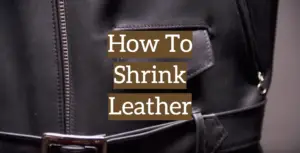
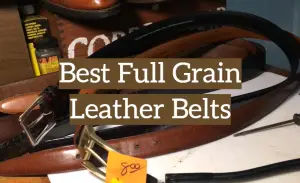
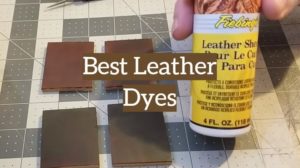
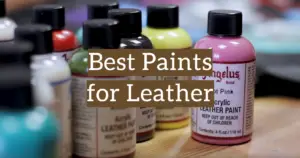

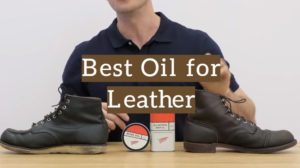
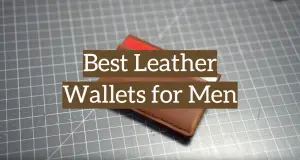

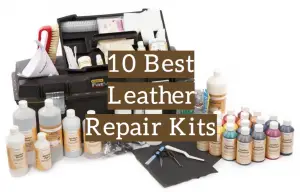
If you are thinking about getting leather car seats, you made the right choice. There is nothing else that compares to the quality of a leather seat. It simply feels great to sit in. All of these leathers would be fine in a car; however, my personal choice would be the REED leather. It looks and feels great.
I made the decision to put a basic leather seat cushion on all my car seats last year. The upholstery process was a challenge, but well worth it in the end! I undertook the whole process by myself and would certainly do so again. The video here gives a nice overview. Thanks!
Hello, thanks for your comment!